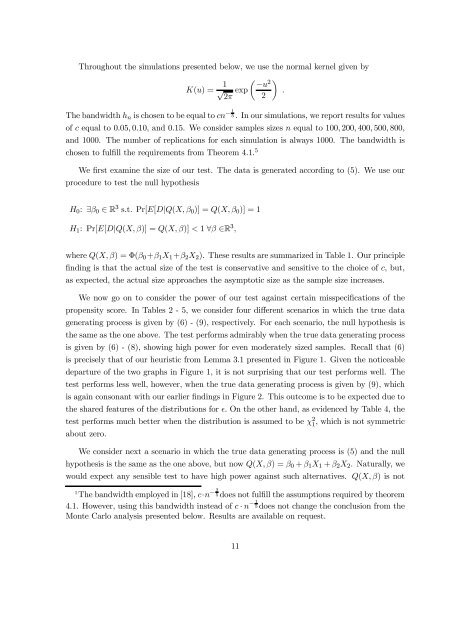On the Identification of Misspecified Propensity Scores - School of ...
On the Identification of Misspecified Propensity Scores - School of ...
On the Identification of Misspecified Propensity Scores - School of ...
Create successful ePaper yourself
Turn your PDF publications into a flip-book with our unique Google optimized e-Paper software.
Throughout <strong>the</strong> simulations presented below, we use <strong>the</strong> normal kernel given by<br />
K(u) = 1<br />
<br />
−u2 √ exp .<br />
2π 2<br />
1<br />
− The bandwidth hn is chosen to be equal to cn 5 . In our simulations, we report results for values<br />
<strong>of</strong> c equal to 0.05, 0.10, and 0.15. We consider samples sizes n equal to 100, 200, 400, 500, 800,<br />
and 1000. The number <strong>of</strong> replications for each simulation is always 1000. The bandwidth is<br />
chosen to fulfill <strong>the</strong> requirements from Theorem 4.1. 5<br />
We first examine <strong>the</strong> size <strong>of</strong> our test. The data is generated according to (5). We use our<br />
procedure to test <strong>the</strong> null hypo<strong>the</strong>sis<br />
H0: ∃β0 ∈ R 3 s.t. Pr[E[D|Q(X, β0)] = Q(X, β0)] = 1<br />
H1: Pr[E[D|Q(X, β)] = Q(X, β)] < 1 ∀β ∈R 3 ,<br />
where Q(X, β) = Φ(β0+β1X1+β2X2). These results are summarized in Table 1. Our principle<br />
finding is that <strong>the</strong> actual size <strong>of</strong> <strong>the</strong> test is conservative and sensitive to <strong>the</strong> choice <strong>of</strong> c, but,<br />
as expected, <strong>the</strong> actual size approaches <strong>the</strong> asymptotic size as <strong>the</strong> sample size increases.<br />
We now go on to consider <strong>the</strong> power <strong>of</strong> our test against certain misspecifications <strong>of</strong> <strong>the</strong><br />
propensity score. In Tables 2 - 5, we consider four different scenarios in which <strong>the</strong> true data<br />
generating process is given by (6) - (9), respectively. For each scenario, <strong>the</strong> null hypo<strong>the</strong>sis is<br />
<strong>the</strong> same as <strong>the</strong> one above. The test performs admirably when <strong>the</strong> true data generating process<br />
is given by (6) - (8), showing high power for even moderately sized samples. Recall that (6)<br />
is precisely that <strong>of</strong> our heuristic from Lemma 3.1 presented in Figure 1. Given <strong>the</strong> noticeable<br />
departure <strong>of</strong> <strong>the</strong> two graphs in Figure 1, it is not surprising that our test performs well. The<br />
test performs less well, however, when <strong>the</strong> true data generating process is given by (9), which<br />
is again consonant with our earlier findings in Figure 2. This outcome is to be expected due to<br />
<strong>the</strong> shared features <strong>of</strong> <strong>the</strong> distributions for ǫ. <strong>On</strong> <strong>the</strong> o<strong>the</strong>r hand, as evidenced by Table 4, <strong>the</strong><br />
test performs much better when <strong>the</strong> distribution is assumed to be χ2 1 , which is not symmetric<br />
about zero.<br />
We consider next a scenario in which <strong>the</strong> true data generating process is (5) and <strong>the</strong> null<br />
hypo<strong>the</strong>sis is <strong>the</strong> same as <strong>the</strong> one above, but now Q(X, β) = β0 + β1X1 + β2X2. Naturally, we<br />
would expect any sensible test to have high power against such alternatives. Q(X, β) is not<br />
5 − The bandwidth employed in [18], c·n 2<br />
5 does not fulfill <strong>the</strong> assumptions required by <strong>the</strong>orem<br />
1<br />
− 4.1. However, using this bandwidth instead <strong>of</strong> c · n 5 does not change <strong>the</strong> conclusion from <strong>the</strong><br />
Monte Carlo analysis presented below. Results are available on request.<br />
11
















